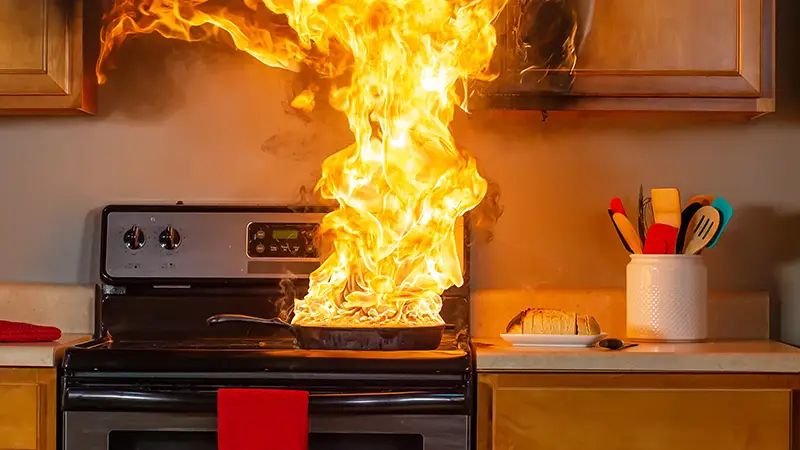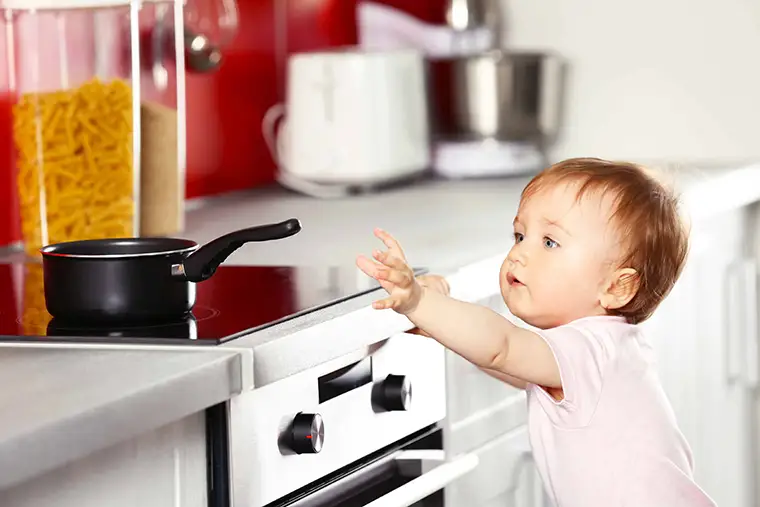
Contents
The kitchen is often the heart of the home, but it’s also one of the most common places for fires to start. Cooking fires are the leading cause of home fires and home injuries, according to the National Fire Protection Association (NFPA). The good news is that many kitchen fires are preventable with a few simple precautions. In this article, we’ll cover the most common causes of kitchen fires and offer tips on how you can keep your kitchen — and your home — safe from fire hazards.
Kitchen Fire Prevention Tips

- Never Leave Cooking Unattended
- If you need to leave the kitchen while cooking, even for a short period, turn off the stove. It’s easy to get distracted, and a few minutes away could be the difference between a controlled situation and a fire.
- Be Mindful of Oil and Grease
- When frying or cooking with oil, keep a close eye on the temperature to prevent overheating. If oil starts to smoke, turn off the heat immediately as it’s a sign that it’s close to igniting.
- Keep the area around your stovetop free from grease build-up, which can ignite easily.
- Keep Flammable Items Away from the Stove
- Always keep towels, pot holders, paper towels, wooden utensils, and other flammable items away from burners and heat sources.
- Opt for non-flammable or heat-resistant items whenever possible.
- Install and Maintain Smoke Detectors
- Ensure that you have a working smoke detector installed near the kitchen but not directly in it to avoid false alarms while cooking. Test the smoke detector monthly and replace the batteries at least once a year.
- Have a Fire Extinguisher on Hand
- Keep a fire extinguisher in the kitchen that’s rated for Class K (kitchen fires) or Class B (flammable liquids like grease and oil). Ensure everyone in the household knows how to use it by following the P.A.S.S. method: Pull, Aim, Squeeze, Sweep.
- Be Cautious with Electrical Appliances
- Regularly inspect kitchen appliances for any signs of wear or damage, such as frayed cords. Unplug appliances when not in use and avoid overloading outlets.
- Use kitchen appliances according to the manufacturer’s instructions to avoid overheating or malfunctioning.
- Create a Safe Cooking Zone
- Maintain a “kid-free” zone of at least three feet around the stove to prevent accidents. Pets should also be kept away from cooking areas to avoid knocking over pots or pans.
- Microwave Safety
- Avoid using metal objects, including aluminum foil, in the microwave as they can spark and cause a fire.
- Never leave food in the microwave unattended, especially foods that have high fat content, like butter or meats, which can overheat and start a fire.
What to Do in Case of a Kitchen Fire

If a fire starts in your kitchen, it’s crucial to act quickly, but safely. Here’s what to do:
- For Small Fires:
- Stovetop Fires: If a small fire breaks out in a pan, cover it with a lid to smother the flames and turn off the heat. Never use water, as it can cause the fire to spread.
- Oven Fires: Keep the oven door closed and turn off the oven. The lack of oxygen should help to extinguish the fire. Wait for the fire to go out completely before opening the door.
- Microwave Fires: Keep the microwave door closed and turn off the appliance immediately. Unplug it if safe to do so and wait for the fire to die down.
- For Larger Fires:
If the fire becomes too large to control, evacuate your home immediately and call 911. Do not attempt to extinguish a fire if it is spreading rapidly.
Final Thoughts
Preventing kitchen fires starts with awareness and preparation. By keeping a close eye on what you’re cooking, maintaining a clutter-free cooking area, and having safety equipment like smoke detectors and fire extinguishers in place, you can significantly reduce the risk of a kitchen fire in your home.
Stay safe and protect your home by practicing these fire safety tips every time you step into the kitchen!
Recent Posts
The Hidden Dangers of Lithium-Ion Battery Fires and How to Prevent Them
From powering our smartphones and laptops to fueling electric vehicles, lithium-ion batteries have revolutionized how
Historic Fires and How they Changed Fire Safety
The Great Chicago Fire (1871) The Great Chicago Fire broke out on October 8, 1871,
Understanding Fire Classes and Their Hazards
Fires are not all the same. They vary in nature, fuel source, and behavior, which
